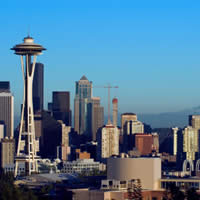Scaffolding
USASeattle Scaffolding
Scaffold Industry News
 Scaffolding made from sustainable materials as the wave of the future? Well, maybe for the city of Seattle, anyway. As of 2000, Seattle enacted a Sustainable Building Policy, requiring all new city-funded renovations and construction projects to obtain LEED Silver rating. In order to obtain this LEED certification, all aspects of the projects must implement sustainable practices and materials, including construction. Considering scaffolds are a necessity for nearly all construction projects, it is only expected that contractors will start to use sustainable materials for Seattle scaffolding structures.
Scaffolding made from sustainable materials as the wave of the future? Well, maybe for the city of Seattle, anyway. As of 2000, Seattle enacted a Sustainable Building Policy, requiring all new city-funded renovations and construction projects to obtain LEED Silver rating. In order to obtain this LEED certification, all aspects of the projects must implement sustainable practices and materials, including construction. Considering scaffolds are a necessity for nearly all construction projects, it is only expected that contractors will start to use sustainable materials for Seattle scaffolding structures.
Sustainable scaffolding is not a new concept. In fact, “green” scaffolds have been used in Asia for a very long time and continue to be used to this day. What makes these scaffolds sustainable is the material from which it they are built, namely, bamboo. Bamboo is renowned as a highly-sustainable material that grows very quickly and is lightweight, yet strong. Thus, bamboo scaffolds are flexible, portable and secure.
However, some naysayers do not think scaffolding should be constructed of bamboo alone. For these people, a hybrid of bamboo and steel scaffolds can be erected. These structures are still far more sustainable than typical metal scaffolds, and offer the flexibility of bamboo with the added strength of steel reinforcement. This type scaffolding is also economical, an added incentive for many contractors or building owners whose interests lie in cutting costs.
Aside from sustainable scaffolding, many other aspects of construction projects in Seattle must be sustainable in order to obtain LEED certification. In fact, implementing green practices and materials into all aspects and phases of a project is required. Some of these sustainable facets include waste management; proper ventilation during construction for improved air quality; low-emitting materials such as sealants, paints and primers; green building materials and so on.
Since enacting the Sustainable Building Policy, Seattle has been thrust forward as one of the top cities in the nation for LEED facilities and is expected to become one of the largest owners of LEED facilities within the next five years. With Seattle’s policy and many others like it sprouting up all over the nation and world, green building initiatives will gain greater emphasis as we all work harder to reduce our ecological footprint.
Green building starts from the ground up with sustainable design practices and construction materials. Seattle may be the first to start this trend, but other U.S. cities are likely to follow suit with sustainable building policies. Although bamboo scaffolding as the gold standard may not be in the near future, be prepared to see more sustainable scaffolds, construction materials and green practices for new projects all over the U.S.